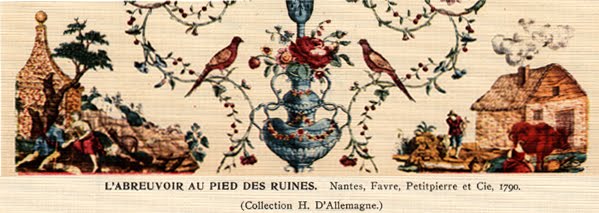A slow day in Charleston
I can't think of a better way to start a blog on antique linens than with a story of a great find. The kind of find that keeps collector/dealers going even in tough times, and these are as tough as they come. Fortunately, that's for selling, not buying.
Charleston is my favorite city and the monthly Nelson Garrett's show in the Gaillard Auditorium is my favorite show; friendly dealers, lots of great antiques without wading through tables of depression glass and California pottery. And the Southern soul food at the cafe is amazing. This coming from a collard greens aficionado.
But, a few months ago, even Charleston couldn't shine through pouring Spring rain and lack of browsers, let alone buyers. So I did what bored antique dealers always do, shopped the other dealers' stock. Several times.
I nearly overlooked the two deteriorating folio sized books tucked under a faience bowl, a trio of Victorian brackets and a handful of carpet balls. Holding the bowl and brackets in my hand --eclectic pieces crammed the space, not leaving a place to put anything down --I scanned the books. Hmm. The books were in French, which I don't read. The title involved toile, a specialty area that leaves me with just enough knowledge to know it is classic and hot. The price was a bit steep for a gamble, and I wandered off.
Volumes minus the bowl, brackets and carpet balls.
On a second pass, I found a place for the bowl. The tan paper wrappers and crumbling back strips shouted "small print run." I lifted the first volume carefully. Under it, sprinkled with chips from the Vol. I, Vol. II was not a book, but a ribbon tied slip case over a thick stack of boards. I could see framed prints in my somewhat country French rooms and the lovely shabby chic volumes on my shelves.
The third time I took a check.
La Toile!
Although I prize my books, the web is a wonderful thing. A day later, one where instead of lounging on the Hilton Head beach I put out the "do not disturb" sign, spread the books and boards on the bed, opened the laptop and prayed to the Google gods. And fed text into freetranslation.com.
The set is La toile imprimée et les indiennes de traite, by Henry-René d'Allemagne. Paris: Librairie Gründ, 1942, It's a history of the birth and evolution of French toile de Jouy including plates from the 18th and 19th century. The seminal reference on French toile.
Books with attached plate in Vol. I. See below for full plate.
Only 600 copies were printed; 100 went back to the author for family and friends, as inscribed on the frontispiece. There is a copy at Musée de la Toile de Jouy in Jouy-en-Josas, the birthplace of toile, where it is listed as one of nine top toile history references. There is one in the collection of The Center for Social Research on Old Textiles in France. A months long search shows there are only two copies for sale, both through AbeBooks, one comparable in France and one a Vol. I-only in California. Evidently, someone parted out the boards from the latter. A conservative value on parting out the books and selling the prints individually is $10,000-15,000.
The plates are mostly collotypes, some hand colored, some from copper engravings. All wonderfully done from, it appears from my poor translation, line drawings and photo plates of the original toiles.
Vol. II, a fan of toile prints.
"L'Abreuvoir au Pied des Ruines. Nantes, Favre, Petitpierre et Cie, 1790"
The full plate, part of which I incorporated in this blog's header. All toile prints are titled.
Before La Toile, printed fabrics, antique French or otherwise, were barely in my orbit. Linen damasks, specifically 17th to 19th century damasks, are my passion. Laces leave me breathless. But I find myself entranced, surrounded by images of florals popular 300 years ago, class Greek and Roman vignettes and intricate representations of then contemporary slices of life, from battles to bucolic life. During this journey, as a friend Kate Henry told me would happen, I'm picking up French along with a rich knowledge of toile. I've also acquired an upgraded, large format scanner and a talent for properly separating uncut folio pages.
In the end, I don't think I'll go the way of most Roadshowers. This one isn't going to auction anytime soon, if ever.
"Les Travaux de la Manufacture, Jouy, Oberkampf, 1783"
Perhaps the most recognizable toile in the world. It shows the story of toile making. Below is a close up.
Perhaps the most recognizable toile in the world. It shows the story of toile making. Below is a close up.







